Richmond, Virginia (December 13, 2016) — The Virginia Energy Efficiency Council (VAEEC) has welcomed a new Chair of the Board of Directors, David Steiner, President and CEO of D+R International Ltd. Steiner takes over at a critical moment for energy efficiency in the Commonwealth, with the industry growing at a rapid clip and the spotlight shifting to state-level energy policies.
“As we look to the future, the VAEEC knows we have a variety of challenges ahead of us to reinforce the power and benefits that energy efficiency can bring to Virginia,” said Steiner. “The VAEEC membership is a wide array of all that makes our Commonwealth function – from business to government, academia to laborers, and residential, commercial and industrial players. We will seek every opportunity to advance Virginia’s most cost-effective energy solution: energy efficiency. The VAEEC invites business, political and community leaders – of all stripes – to join us in leading Virginia forward.”
to reinforce the power and benefits that energy efficiency can bring to Virginia,” said Steiner. “The VAEEC membership is a wide array of all that makes our Commonwealth function – from business to government, academia to laborers, and residential, commercial and industrial players. We will seek every opportunity to advance Virginia’s most cost-effective energy solution: energy efficiency. The VAEEC invites business, political and community leaders – of all stripes – to join us in leading Virginia forward.”
Steiner has led D+R International since 2010, a company with a 30-year history of supporting innovative program design for energy efficiency adoption. The company focuses on high quality data that brings greater understanding of energy efficiency opportunities and ultimately capture of energy savings. It has pioneered the Market Lift® program that has succeeded in pushing the market to higher efficient products.
David will be replacing Cynthia Adams as the Chair of the VAEEC. “On behalf of the entire VAEEC membership and Board of Directors, I want to express our heartfelt thanks to Cynthia Adams for her untiring leadership and passion in creating this voice for energy efficiency in the Commonwealth of Virginia,” said Steiner. “No doubt, the VAEEC would not exist without her guiding hand. She has been a stalwart advocate for ensuring that energy efficiency is top of mind with policy makers and program developers when confronting energy and environmental challenges. We look forward to her continued involvement and dedication to the next phase of our mission.”
“VAEEC and really the entire energy efficiency industry in Virginia owe a debt of gratitude to Cynthia,” said Chelsea Harnish, VAEEC’s Executive Director. “Since first conceiving of the idea of VAEEC five years ago, Cynthia has been a tireless champion of the organization and has provided sage counsel, a network of connections, and a reservoir of momentum. We look forward to her continued support as a member of the board and welcome the new leadership to the VAEEC Executive Committee.”
VAEEC will also welcome new executive positions on the board, with David Koogler, Vice President of Member Services & External Affairs for Rappahannock Electric Cooperative entering the role of Vice Chair and John Morrill, Energy Manager for Arlington County stepping in as Secretary. Bill Greenleaf Loan Officer with Virginia Community Capital will remain as Treasurer.
The 2017 VAEEC Board of Directors and Executive Committee:
Chair: David Steiner, D+R International
Vice Chair: David Koogler, Rappahannock Electric Cooperative
Secretary: John Morrill, Arlington County
Treasurer: Bill Greenleaf, Virginia Community Capital
Cynthia Adams, Pearl Certification
Bill Beachy, Community Housing Partners
Larry Cummings, Trane
Carla Dix, Columbia Gas of Virginia
Andrew Grigsby, Local Energy Alliance Program
Tom Jewell, Dominion Virginia Power
Saifur Rahman, Virginia Tech
Thomas Nicholas, City of Virginia Beach
Marisa Uchin, Oracle/Opower
Read more about the Board of Directors.
The Virginia Energy Efficiency Council is the voice for the energy efficiency industry in the Commonwealth. Our members include Fortune 500 companies, universities, nonprofits, local governments, state agencies, and utilities. The Council’s goal is to ensure that energy efficiency is an integral part to Virginia’s economy and clean energy future. Together, we are creating, implementing, and sharing energy efficiency solutions that keep costs down for residents and businesses, while improving the quality of life in our work and home environments. www.vaeec.org
Winners Honored by Virginia Energy Efficiency Council (VAEEC) and Governor McAuliffe at Richmond reception
Photos from the awards ceremony can be found on our Facebook page and Google Drive.
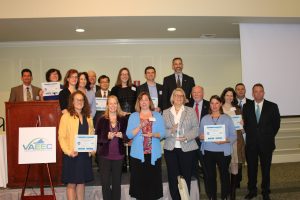 Richmond, Virginia (November 29, 2016) – The Virginia Energy Efficiency Council (VAEEC) honored the winners of its first-ever Virginia Energy Efficiency Awards at a reception in Richmond tonight attended by Governor Terry McAuliffe. VAEEC received more than 50 nominations for the 6 awards which showcase how energy efficiency champions across the Commonwealth are helping businesses, schools, government and homeowners save money on energy expenditures while reducing energy consumption — all while stimulating job growth and our economy.
Richmond, Virginia (November 29, 2016) – The Virginia Energy Efficiency Council (VAEEC) honored the winners of its first-ever Virginia Energy Efficiency Awards at a reception in Richmond tonight attended by Governor Terry McAuliffe. VAEEC received more than 50 nominations for the 6 awards which showcase how energy efficiency champions across the Commonwealth are helping businesses, schools, government and homeowners save money on energy expenditures while reducing energy consumption — all while stimulating job growth and our economy.
“Congratulations to all of the Virginia Energy Efficiency Leadership Awards winners, and thank you for your contributions to the new Virginia economy,” said Governor Terry McAuliffe, who presented all 18 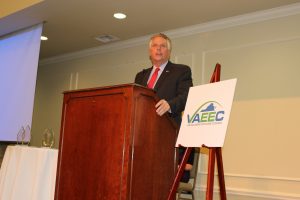 winners with their awards. “Tonight we recognize your achievements and celebrate the tremendous progress that we are making together on energy efficiency in the Commonwealth. Thank you to the Governor’s Executive Committee on Energy Efficiency for creating this vision and to the Virginia Energy Efficiency Council for pursuing that vision and supporting an industry that is vital to helping build a new Virginia economy.”
winners with their awards. “Tonight we recognize your achievements and celebrate the tremendous progress that we are making together on energy efficiency in the Commonwealth. Thank you to the Governor’s Executive Committee on Energy Efficiency for creating this vision and to the Virginia Energy Efficiency Council for pursuing that vision and supporting an industry that is vital to helping build a new Virginia economy.”
“The winning entries are proof that energy efficiency has tremendous potential to drive economic growth, create jobs, shrink utility bills, conserve natural resources and reduce pollution. They reflect the preliminary numbers from our 2016 Clean Energy Census which indicate that building energy efficiency alone accounts for $1.1B in annual revenue,” said Chelsea Harnish, VAEEC Executive Director.“We are pleased to use these awards to shine a spotlight on innovative approaches, positive impacts in our communities, unique partnerships and replicable and scalable programs. Congratulations to the winners and thanks to all 50+ applicants.”
Any person, entity or group who works on energy efficiency in Virginia was eligible for the Awards which were chosen by a Selection Committee, comprised of members of the VAEEC Education and Outreach Committee and additional volunteer members of VAEEC.
Winners: 2016 Virginia Energy Efficiency Leadership Awards
Academic
1st Place: Manassas Park Elementary School & Pre-Kindergarten
Submitted by 2rw Consultants, Inc.
2nd Place (tie): Get2Green
Submitted by Fairfax Public Schools
Henry County Public Schools
Submitted by Henry County Public Schools
Commercial
1st Place: Development of PACE Financing in Virginia
Submitted by Abacus Property Solutions, Virginia Community Capital, and McGuireWoods Consulting
2nd Place: Ballston Garage LED Retrofit
Submitted by Arlington County
3rd Place: Exact Energy Inc.
Submitted by Exact Energy, Inc.
Local Government
1st Place: Henrico County
Submitted by Henrico County
2nd Place: City of Virginia Beach
Submitted by City of Virginia Beach
3rd Place: Fontaine Fire Station
Submitted by 2rw Consultants, Inc.
Low-Income
1st Place: Live Stream Distance Learning Energy Efficiency Project
Submitted by Community Housing Project
2nd Place: Appalachian Power Company (APCO)
Submitted by Association of Energy Conservation Professionals
3rd Place: Arlington-Alexandria Energy Masters
Submitted by Arlington Alexandria Office of the Virginia Cooperative Extension, Arlingtonians for a Clean Environment, and Arlington Thrive
Residential
1st Place: WarmWise Web-Based Home Audit Program
Submitted by Columbia Gas of Virginia and Richmond ARC
2nd Place: 1922 Blair Street
Submitted by Bain-Waring Home Energy Remodeling, RIC Design Build, and Richmond Region Energy Alliance
3rd Place: Alexandria Renew Enterprises
Submitted by AlexRenew
State Government
1st Place: Virginia Department of Corrections
Submitted by the Virginia Department of Corrections
2nd Place: Department of Mines, Minerals and Energy Division of Energy
Submitted by the Department of Mines, Minerals and Energy Division of Energy
3rd Place: Department of Mines, Minerals and Energy
Submitted by the Department of Mines, Minerals and Energy
Academic
Manassas Park Elementary School & Pre-Kindergarten
Submitted by 2rw Consultants, Inc.
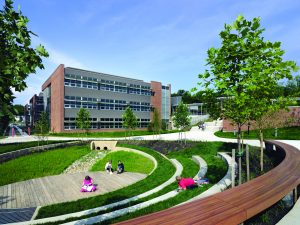 The new Manassas Park Elementary School and Pre-Kindergarten were built with the goal to create a campus that was not only environmentally sustainable but that was also a resource to teach students about environmental stewardship. The buildings are designed to meet the American Institute of Architects (AIA) 2030 Challenge and use 50% less energy than code-compliant schools. Features include photo-sensors, which activate artificial light only when needed to supplement natural lighting; ground-source heat pumps, variable-speed pumping, pre-treatment and total energy recovery for ventilation air; natural ventilation; rainwater harvesting; low-consumption fixtures and kitchen equipment.
The new Manassas Park Elementary School and Pre-Kindergarten were built with the goal to create a campus that was not only environmentally sustainable but that was also a resource to teach students about environmental stewardship. The buildings are designed to meet the American Institute of Architects (AIA) 2030 Challenge and use 50% less energy than code-compliant schools. Features include photo-sensors, which activate artificial light only when needed to supplement natural lighting; ground-source heat pumps, variable-speed pumping, pre-treatment and total energy recovery for ventilation air; natural ventilation; rainwater harvesting; low-consumption fixtures and kitchen equipment.
Commercial
Development of PACE Financing in Virginia: 1st Place
Submitted by Abacus Property Solutions, Virginia Community Capital, and McGuireWoods Consulting
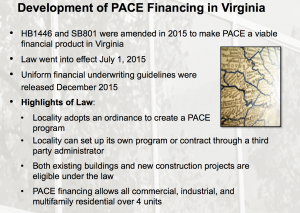 The team was largely responsible for fixing the flawed Property Assessed Clean Energy (PACE) legislation in 2015, which previously did not give the PACE lien priority over existing mortgage holders. Through their efforts, the PACE legislation passed easily – where previous years’ efforts to modify the statute failed – with very little opposition in the General Assembly. Since the legislation went into effect in July 2015, the team has been active in building interest, support and knowledge of the value proposition of PACE throughout the state.
The team was largely responsible for fixing the flawed Property Assessed Clean Energy (PACE) legislation in 2015, which previously did not give the PACE lien priority over existing mortgage holders. Through their efforts, the PACE legislation passed easily – where previous years’ efforts to modify the statute failed – with very little opposition in the General Assembly. Since the legislation went into effect in July 2015, the team has been active in building interest, support and knowledge of the value proposition of PACE throughout the state.
Local Government
Henrico County: 1st Place
Submitted by Henrico County
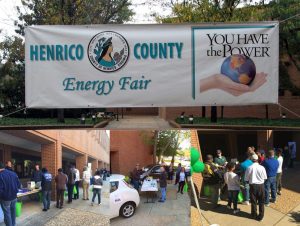 The mission of Henrico County’s Energy Management program and energy manager is to develop Henrico County Government and Schools as the leading local authorities for sustainable energy use and to promote the importance of good energy management for the economic and environmental well-being of the county’s residents and employees. The Energy Management program also strives to improve energy education and foster a culture of efficiency and sustainability in the County, while the Energy Manager supports green design and construction efforts for capital projects. Completed projects include energy audits, HVAC and lighting system upgrades, participation in demand response programs, commissioning and retro-commissioning, traffic and street light upgrades, building automation systems, and construction of a 4-megawatt methane gas to electricity generator at the landfill.
The mission of Henrico County’s Energy Management program and energy manager is to develop Henrico County Government and Schools as the leading local authorities for sustainable energy use and to promote the importance of good energy management for the economic and environmental well-being of the county’s residents and employees. The Energy Management program also strives to improve energy education and foster a culture of efficiency and sustainability in the County, while the Energy Manager supports green design and construction efforts for capital projects. Completed projects include energy audits, HVAC and lighting system upgrades, participation in demand response programs, commissioning and retro-commissioning, traffic and street light upgrades, building automation systems, and construction of a 4-megawatt methane gas to electricity generator at the landfill.
Low-Income
Live Stream Distance Learning Energy Efficiency Project: 1st Place
Submitted by Community Housing Project
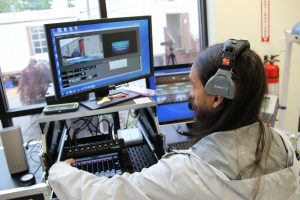 Community Housing Partners’ (CHP) innovative energy efficiency training project involved a live broadcast from a manufactured home in Virginia to the statewide Weatherization Assistance Program (WAP) conference in Minnesota. Having been a WAP provider for 40 years, CHP knows firsthand the importance of equipping WAP crew members with the knowledge, skills, and abilities to produce quality work resulting in maximum energy savings for the low-income households served by the program. CHP developed a 3.5 hour live-stream training session with relevant predefined topics and real-time Q&A, which enabled CHP to develop a new approach to energy efficiency training that will be replicated nationally, and potentially internationally.
Community Housing Partners’ (CHP) innovative energy efficiency training project involved a live broadcast from a manufactured home in Virginia to the statewide Weatherization Assistance Program (WAP) conference in Minnesota. Having been a WAP provider for 40 years, CHP knows firsthand the importance of equipping WAP crew members with the knowledge, skills, and abilities to produce quality work resulting in maximum energy savings for the low-income households served by the program. CHP developed a 3.5 hour live-stream training session with relevant predefined topics and real-time Q&A, which enabled CHP to develop a new approach to energy efficiency training that will be replicated nationally, and potentially internationally.
Residential
WarmWise Web-Based Home Audit Program: 1st Place
Submitted by Columbia Gas of Virginia and Richmond ARC
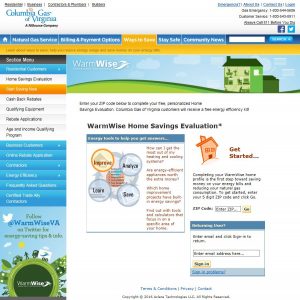 Columbia Gas of Virginia’s Web-Based Home Audit Program allows residential customers to participate in their own energy analysis and places them in the “driver’s seat” of achieving an energy efficient future. Customers participating in an online home energy audit receive a customized report recommending home improvements that can be implemented to reduce natural gas usage. Through the end of 2015, CGV’s customers have achieved over $4M in savings through the program.
Columbia Gas of Virginia’s Web-Based Home Audit Program allows residential customers to participate in their own energy analysis and places them in the “driver’s seat” of achieving an energy efficient future. Customers participating in an online home energy audit receive a customized report recommending home improvements that can be implemented to reduce natural gas usage. Through the end of 2015, CGV’s customers have achieved over $4M in savings through the program.
State Government
Virginia Department of Corrections: 1st Place
Submitted by the Virginia Department of Corrections
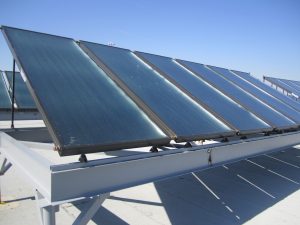 The Virginia Department of Corrections (VADOC) executed the first executive branch energy services contract (ESCO) in Virginia, leads Virginia in ESCO volume, and has embraced ESCOs as an integral part of its building renewal program. VADOC has also tied energy efficiency to its public safety mission by creating an inmate training program in energy sector skills. Additionally, VADOC employs a broad fuel portfolio including renewable and alternative energy sources
The Virginia Department of Corrections (VADOC) executed the first executive branch energy services contract (ESCO) in Virginia, leads Virginia in ESCO volume, and has embraced ESCOs as an integral part of its building renewal program. VADOC has also tied energy efficiency to its public safety mission by creating an inmate training program in energy sector skills. Additionally, VADOC employs a broad fuel portfolio including renewable and alternative energy sources
About the VAEEC
The Virginia Energy Efficiency Council is the voice for the energy efficiency industry in the Commonwealth. Our members include Fortune 500 companies, universities, nonprofits, local governments, state agencies, and utilities. The Council’s goal is to ensure that energy efficiency is an integral part to Virginia’s economy and clean energy future. Together, we are creating, implementing, and sharing energy efficiency solutions that keep costs down for residents and businesses, while improving the quality of life in our work and home environments. www.vaeec.org
Virginia’s power mix is making the clean energy shift, and it has significant opportunities for progress in improving its energy efficiency. This analysis comes from a new report from the Business Council for Sustainable Energy (BCSE), a coalition of clean energy companies that promotes the adoption of market-ready clean and sustainable energy products and services and a VAEEC partner, together with Bloomberg New Energy Finance.
Compared to the rest of the country, the Commonwealth’s carbon emissions are lower than the national average and it has lower than average power prices.
The Virginia Clean Energy Factsheet shows that Virginia is making positive steps towards a diversified energy portfolio. Overall, the Factsheet finds that last year Virginia ranked 10th in total electricity consumption, and 17th in electricity generation. This makes Virginia one of the nation’s biggest electricity importers. Natural gas provided a record 39% of electricity in 2015, while renewables grew to 5.3%. The remaining generation comes from nuclear (33%) and coal (21%).
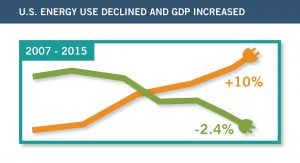
The Factsheet contains more data and analysis on the energy efficiency, renewable energy, and natural gas sectors in Virginia – providing a succinct look at Virginia’s power sector as it diversifies and moves to a lower carbon energy mix.
It also highlights that there are significant opportunities for energy savings to be realized through energy efficiency measures and programs. The right energy efficiency programs can reduce energy costs for consumers, benefit the economy, and reduce emissions. They can also help make Virginia more energy independent.
Nationwide, energy efficiency programs and services implemented over the past several decades have contributed significantly to the increased energy productivity of the U.S. economy. According to BCSE’s 2016 Sustainable Energy in America Factbook, energy efficiency has led to the decoupling of GDP and energy consumption; between 2007 and 2015, GDP went up 10%, while energy consumption actually went down by 2.4%. This means that every unit of GDP requires less and less energy spending to produce.
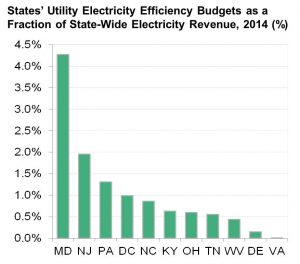
National spending on these energy efficiency programs grew 25% per year from 2006 to 2011, reflecting the growing acknowledgement of its economic and energy benefits.
Despite this surge in national spending on energy efficiency, Virginia has not been as quick to make similar investments. Virginia ranks 31st according to ACEEE’s energy efficiency scoring system, and ranks last among states in utility spending on energy efficiency as a percentage of revenue. In 2014, Virginia spent just .01% of electricity revenues on energy efficiency programs, while Maryland and New Jersey (states that also operate in the PJM market) spend 4.3% and 2.0%, respectively.
Investments in energy efficiency products and services have demonstrable benefits to consumers. From 2010 to 2015, as national spending increased, consumers actually saw reductions in their electricity use and bills. The Factbook shows that the average U.S. residential customer used 6.2% less electricity, despite owning more gadgets, and paid about $80 less in real dollars on their electricity bills annually.
In Virginia, the Factsheet shows the energy savings potential is a cumulative 23% by 2030. That means avoiding 25TWh of generation in 2030.
Given these benefits, as the Governor’s Executive Order 57 Working Group on emissions reduction continues to seek ways to reduce the Commonwealth’s carbon footprint, energy efficiency should be prioritized. It is a cost effective way to cut back on emissions that also saves money for consumers.
Other policy makers are well positioned to take action on energy efficiency. The General Assembly took an important step towards advancing energy efficiency in the Commonwealth by mandating that the State Corporation Commission evaluate the establishment of uniform protocols for measuring verifying, validating, and reporting on the impacts of utility energy efficiency programs. Establishing a robust system for evaluation, measurement, and verification (EM&V) will be crucial to the success of energy efficiency programs. BCSE has recommended that the SCC consider the many well established resources available on EM&V as it makes decisions about how Virginia will move forward with EM&V protocols.
The Commonwealth is in a good position to deepen its commitment to an economic growth pathway that further embraces a diverse portfolio of clean energy resources. Energy efficiency is a key component of that portfolio, and one through which Virginia stands to gain significant economic and energy saving benefits.
 This guest blog post was written for VAEEC by Carolyn Sloan, Manager, Federal Policy, with the Business Council for Sustainable Energy.
This guest blog post was written for VAEEC by Carolyn Sloan, Manager, Federal Policy, with the Business Council for Sustainable Energy.
For more information on the Business Council for Sustainable Energy and to download a free copy of the Virginia Factsheet and Sustainable Energy Factbook please visit bcse.org/sustainableenergyfactbook.
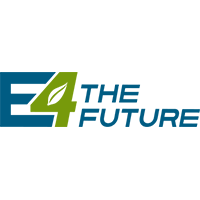 Variability among state/regional structures and rules is a barrier to achieving a well-functioning energy market that provides clean and cost-effective electricity. That’s the conclusion of a paper published by VAEEC Business Platinum member E4TheFuture, November’s Featured Member of the Month. E4TheFuture intends that the paper will help inform organizations who wish to improve governance structures and market rules.
Variability among state/regional structures and rules is a barrier to achieving a well-functioning energy market that provides clean and cost-effective electricity. That’s the conclusion of a paper published by VAEEC Business Platinum member E4TheFuture, November’s Featured Member of the Month. E4TheFuture intends that the paper will help inform organizations who wish to improve governance structures and market rules.
Which areas of the U.S. enable the voices of clean energy and advanced energy technology advocates as decision-makers in the market structures — such as PJM Interconnection* — that govern their playing field? To what extent are these voices provided a vote, compared with traditional power generators, transmission and distribution companies, utility regulators, and “legacy” leadership? How is the Federal Energy Regulatory Agency (FERC) involved? Can missed opportunities of the past be transformed from challenges into opportunities? These questions are raised in E4TheFuture’s paper, authored by Synapse Energy Economics consultants with an introduction and conclusions by E4TheFuture. The paper, Regional Energy Markets: Do Inconsistent Governance Structures Impede U.S. Market Success?, is available as a free download.
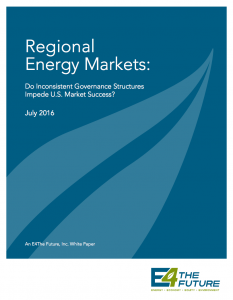 VAEEC member E4TheFuture is a nonprofit that promotes residential clean energy and sustainable resource solutions to advance climate protection and economic fairness. The organization does this by influencing federal, state and local policies, and by helping to build a resilient and vibrant energy efficiency and clean energy sector. “E4” stands for energy, economy, equity, and environment: promoting clean, efficient Energy; growing a low-carbon Economy; ensuring low-income residents can access clean, efficient, affordable energy (Equity); restoring a healthy Environment for people, prosperity and the planet. E4TheFuture was known as Conservation Services Group (CSG), until the sale of its operating programs and brand in 2015 to CLEAResult.
VAEEC member E4TheFuture is a nonprofit that promotes residential clean energy and sustainable resource solutions to advance climate protection and economic fairness. The organization does this by influencing federal, state and local policies, and by helping to build a resilient and vibrant energy efficiency and clean energy sector. “E4” stands for energy, economy, equity, and environment: promoting clean, efficient Energy; growing a low-carbon Economy; ensuring low-income residents can access clean, efficient, affordable energy (Equity); restoring a healthy Environment for people, prosperity and the planet. E4TheFuture was known as Conservation Services Group (CSG), until the sale of its operating programs and brand in 2015 to CLEAResult.

Steve Cowell and Sarah Jackson
In August 2016 president of E4TheFuture Steve Cowell, with Sarah Jackson and Paul Peterson of Synapse Energy Economics, hosted a briefing call about the Regional Energy Markets paper. Jackson and Peterson reviewed each region’s market governance structure, noting what Synapse found and inviting questions.
Of particular interest to VAEEC, it was noted during the briefing that PJM’s current voting members representing advanced energy technology interests are a fragmented group of small companies, which results in a diluted voice on these issues. Paul Peterson pointed out that wind energy advocates are active but overall, more participation by clean energy advocates either via the Public Interest & Environmental Organizations User Group or through development of a separate voting sector such as the Alternative Resources sector in New England, may be helpful. Steve Cowell raised the possibility of creating a user group for PJM’s alternative resource sector, which might be able to evolve into such a voting sector.
“The full range of resources should be explicitly included,” says Steve. “Clean energy resources such as energy efficiency and other distributed energy resources along with demand response need to be more strongly represented in wholesale electricity markets through a more evolved ISO and RTO governance.”
A September 2016 blog by Dylan Reed and Arvin Ganesan of Advanced Energy Economy (AEE), How Grid Governance Stands in the Way of Advanced Energy Progress, recaps the paper’s highlights with additional AEE commentary on the challenges advanced energy resources face under the current variable structures of regional and state electricity market governance.
*PJM Interconnection coordinates the movement of wholesale electricity and ensures power supplies for 61 million people in 13 states & D.C. On October 21, a new Learning Center highlights features of the Markets and Operations page: a real-time snapshot of PJM’s operations and markets, current load, fuel mix, locational marginal prices and ancillary services. The new page explains the dashboard’s wind and solar power graphs.
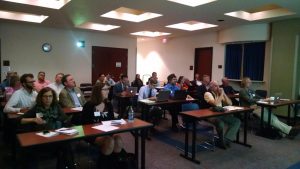 Last week (Oct. 6, 2016), the Virginia Energy Efficiency Council held a successful workshop for utility staff, evaluators, regulators, implementers and other stakeholders on EM+V 2.0 (Evaluation, Measurement + Verification).
Last week (Oct. 6, 2016), the Virginia Energy Efficiency Council held a successful workshop for utility staff, evaluators, regulators, implementers and other stakeholders on EM+V 2.0 (Evaluation, Measurement + Verification).
This past spring, while we at the VAEEC were drafting our comments and collecting those from member organizations to the State Corporation Commission on the establishment of EM+V protocols, we took the opportunity to discuss this concept of “Enhanced EM+V”, “EM+V 2.0” or “Automated EM+V”. For the purposes of this post, we will use the term “EM+V 2.0” moving forward. As we stated in our comments, “these methods can provide opportunities for utilities and regulators to gain program insights in near real-time, speed up the evaluation process and potentially reduce the associated costs.”
During a conference call with our utility members to review and provide feedback on our comments, there was general agreement that a workshop to delve deeper into this complex topic would be useful. In the VAEEC’s role as a resource provider to our members and stakeholders, it made sense for us to take this on.
Our expert presenters came from diverse backgrounds, which allowed our participants to learn about EM+V 2.0 from a variety of different perspectives. Our presenters included:
Katherine began the workshop with a quick primer on EM+V in general, including why evaluation is necessary for utility programs and the advantages and challenges of EM+V 2.0. She also discussed how EM+V 2.0 fit into the bigger picture and provided some examples of which programs it is useful to evaluate and which ones it may not be useful for. She also briefly mentioned her work as the independent evaluator in Arkansas and how that evaluation model works.
Following Katherine, was Maggie Molina with ACEEE who discussed ACEEE’s work in this field and discussed the findings from their report on the subject.
Next, was Jake Oster who works for EnergySavvy, a company whose software is used in this field. Jake discussed their product and provided several client case studies on the residential side.
Jessica Granderson with the Lawrence Berkeley National Lab presented on the EM+V 2.0 pilot programs they are doing as well as providing some examples of commercial EM+V 2.0.
Our last speaker of the day was Tim Petit who summarized some of the content already discussed by previous speakers and went into further detail about a NEEP report that came out recently.
All of their presentations can be accessed via links above and found on our resources page.
Following all of the presentations, we welcomed all of the presenters back to the front of the room for a panel discussion on what had been previously discussed, to answer questions and to start the dialogue on next steps.
We plan to follow up with participants with a survey to get feedback on how to continue the conversation.
From my perspective, simply having the number of participants we had and knowing they were engaged on the issue made this workshop a success. We appreciated the thoughtful questions and the discussion that ensued.
Guest Blog Post: Johnette Johnson, VAEEC intern and University of Richmond student
With a score of 13 points out of a possible 50 (same score as 2015), Virginia dropped two rankings from 31 to 33 in this year’s State Energy Efficiency Scorecard. According to the scorecard press release from the American Council for an Energy Efficient Economy (ACEEE), Virginia’s lower score is due to our inability to keep pace as other states expanded efficiency efforts.
Download the Virginia one-pager, the full State Energy Efficiency Scorecard and report, or the updated Virginia entry in their State and Local Database.
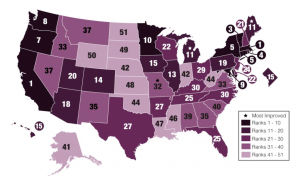 The State Scorecard is a helpful illustration of the strengths and weaknesses of each state’s energy efficiency components and provides an opportunity for all states to learn from each other.
The State Scorecard is a helpful illustration of the strengths and weaknesses of each state’s energy efficiency components and provides an opportunity for all states to learn from each other.
For instance, if we look at Virginia’s utility programs, our scoring is a negative 0.5 points out of 20, placing our utility programs at the 51st rank alongside West Virginia. Virginia’s State Corporation Committee, who regulates utility programs, allocates a very small budget towards electricity and natural gas efficiency programs thereby energy savings are some of the lowest in the country.
The ACEEE also encourages growth in Virginia’s Combined Heat and Power (CHP) sector. CHP is the successful generation of electricity and useful thermal energy in a single, integrate system that produces 80% combined efficiency as opposed to 45% for traditional power plants. However, CHP systems require the purchasing of backup power from the electric grid as well as the selling of excess electricity back to it. A lack of established parameters and procedures for connecting to the grid drives up costs and stifles CHP deployment in Virginia.
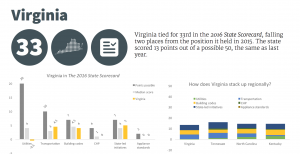 California reaps the benefits of CHP through a total of 28 installations. Another installation of note is their Self-Generation Incentive Program (SGIP) that provides incentive payments to support the commercialization of new, efficient CHP technologies. CA’s CHP energy resources are held to the standards of the Qualifying Facilities and CHP Program Settlement; the program provides targets and requirements that facilitate the efficient production of CHP.
California reaps the benefits of CHP through a total of 28 installations. Another installation of note is their Self-Generation Incentive Program (SGIP) that provides incentive payments to support the commercialization of new, efficient CHP technologies. CA’s CHP energy resources are held to the standards of the Qualifying Facilities and CHP Program Settlement; the program provides targets and requirements that facilitate the efficient production of CHP.
While highlighting other state’s successes, the Scorecard does not fail to recognize Virginia’s innovative efficiency programs. Virginia received a stellar five points out of a possible seven for state-led initiatives, ranking us 10th in the nation for these programs. This performance marks a high potential for the future of the state’s energy efficiency programs. Virginia exhibited notable performances in our building code policies as well, ranking 28th in the country.
The Scorecard can be used as a tool to motivate Virginians to take note of the Commonwealth’s energy efficiency setbacks and to push for improvements that our neighboring states are already implementing.
September 23, 2016
Chelsea Harnish, VAEEC Executive Director
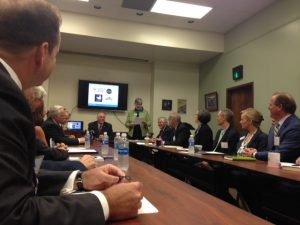 What an inspiring day at the Clean Energy Business Roundtable in Roanoke with Virginia Governor Terry McAuliffe. Plenty of VAEEC members were represented, including Community Housing Partners, Trane, Virginia Community Capital, Oracle (OPower), Appalachian Power and Siemens.
What an inspiring day at the Clean Energy Business Roundtable in Roanoke with Virginia Governor Terry McAuliffe. Plenty of VAEEC members were represented, including Community Housing Partners, Trane, Virginia Community Capital, Oracle (OPower), Appalachian Power and Siemens.
You can track some of the action via #NewVAEconomy.
A few things we heard from folks in the room:
- Governor McAuliffe kicked it off with a number of data-based arguments for energy efficiency and clean energy being cornerstones of the #NewVAEconomy, including: in 2013, the Clean Energy Census for Virginia found that clean energy- including wind, solar, EE, biomass and geothermal- was a $500,000 industry. Looking at preliminary results from our 2016 census, the revenue from this industry jumped to $2.1 billion with EE making up $1.2 billion (and the census is still open).
There was a story from the Roanoke Times that includes that first stat and some other highlights from the day.
- The cap for VA SAVES should be extended beyond $5M. Trane noted that school systems are looking to use this program, but the money will eventually run out. With the interest rate so low, schools could really do more with VA SAVES than current financing structure allows.
- Monica Rokicki with Better Building Works stated that a building-science based approach is critical for any renewable energy and energy efficiency policy decisions. We checked in with Monica after the event and got a bit more detail from her: “We have to factor in health and safety. For example, many clients think insulation is a good thing for energy efficiency in buildings. They are right except that if they don’t account for the fire hazards like air leakage at the tops of buildings or old knob and tube wiring, they are creating a very dangerous situation. Likewise, doing work without measuring before and after ventilation can create very bad air quality issues — making existing ones worse or even creating new ones. This is why independent third party verification by certified auditors is critical.” Plus, it ensures that the energy savings are on par with what we predicted.
- The Roanoke Chamber of Commerce (host of the event), emphasized the need for technical training in high schools. Many in the room agreed with this need and several stated that including facilities manager skills in these programs is key as many people in these positions are at or near retirement age with very few qualified candidates available to fill in.
- Oracle Utilities (OPower was recently purchased by Oracle), which operates worldwide, called for the Department of Mines Minerals and Energy (DMME) to get more involved in SCC proceedings.
- Community Housing Partners highlighted their workforce training programs and noted that baby boomers currently occupy a significant segment of energy-related jobs and they are starting to retire.
- Appalachian Power chimed in with the utility perspective that customers have a hard time paying their bills, so collaboration is key to ensure those who are already struggling don’t have to pay more.
A huge thanks for to the Roundtable participants for taking time out of their busy schedules to share their experiences and expertise and to Governor McAuliffe and his staff for joining and supporting the Commonwealth’s clean energy and energy efficiency industries.
We were proud to help organize the Clean Energy Business Roundtable with our partners at Advanced Energy Economy, AJW Consultants, Chambers for Innovation and Clean Energy (VAEEC member), U.S. Green Building Council (VAEEC member) and the Roanoke Regional Chamber of Commerce.
#NewVAEconomy @GovofVirginia
This blog post was written by David Cohan, Building Energy Codes Program Manager at the U.S. Department of Energy, originally posted to the Office of Energy Efficiency and Renewable Energy website in May 2016, and republished on vaeec.org with permission.
I recently got back from Louisville, Kentucky, where I was representing DOE in the latest round of energy code development hearings. While the people who participate in the development process know energy codes inside and out, I know they are not as clear to the broader public. So let’s take a step back. Here’s a primer on what energy codes are, how they are developed, adopted, and enforced, and what DOE’s role is in these processes. Future blog posts in this series will zoom into specific topics.
First, here are a few key points:
1. CODE DEVELOPMENT
How it works: National model energy codes are developed by two private organizations, ASHRAE and the International Codes Council. ASHRAE develops the model commercial energy code, known as 90.1. The International Code Council develops the International Energy Conservation Code (IECC), which contains chapters for both residential and commercial buildings. Any interested party can participate in the development processes by submitting proposals to change the code and commenting on others’ proposals. The codes cycle is continuous, with new codes being developed every three years. Final versions of each new edition are determined by a vote of the 90.1 committee members for ASHRAE and by the International Code Council membership for the IECC.
DOE’s role: DOE participates in both the ASHRAE and ICC development processes, but has no special status. DOE develops and submit code change proposals that strive to make cost-effective, energy efficient upgrades to current model codes. After each new model code is published, DOE also must determine if the new version saves energy relative to the old version.
Note: David Cohan has another blog worth reading on this topic, “How are Building Energy Codes Developed” from August 2016.
2. CODE ADOPTION
How it works: Most codes are adopted at the state level, though, in about 10 states they are adopted by cities. State adoption can occur directly by legislative action, or through regulatory agencies authorized by the legislature. Cities adopt codes through their mayors, councils, or committees depending on their form of government. Once adopted, the code becomes law within the particular state or local jurisdiction.
DOE’s role: DOE provides technical assistance to state and local governments to support their adoption processes. DOE responds to state and local requests and it also develops customized reports for every state detailing the benefits of upgrading to the current model codes. To ensure that its information is used effectively, DOE works with the Regional Energy Efficiency Organizations (REEOs) and the National Association of State Energy Officials (NASEO) who have connections in almost every state and often participate directly in the adoption processes. DOE support also includes tracking state adoption status, coordinating activities among stakeholders, and technical analysis.
3. CODE COMPLIANCE
How it works: The key to realizing the full savings potential of building energy codes is by ensuring that builders are complying with them. Design and construction professionals are most likely to comply with the code when they are given education and training, particularly after a new code is adopted. Enforcement is almost always done by building permit office staff at the local (city) level who typically review plans first to ensure they are compliant and then conduct field inspections to verify that the plans are being followed during construction.
DOE’s role: DOE develops and regularly updates software (REScheck and COMcheck) to simplify and clarify compliance with model energy codes and standards, as well as a number of state-specific energy codes. DOE also develops education and training materials that are available free and used by governments, organizations and trainers across the country.
DOE has also developed an affordable methodology for states and cities to determine energy and dollar savings opportunities associated with increased energy code compliance in single-family homes. Field studies based on the methodology have already been implemented in nine states with more underway. The data that comes from these studies helps focus education and training programs and provides a basis for utilities and states to determine whether such programs will be cost-effective. DOE is currently developing a parallel methodology for the commercial sector.
 Established in 1998, PEG is a Woman-owned multi-disciplinary engineering, environmental and energy consulting firm that is experienced in working with Residential Construction, Local and Federal Government Agencies, Non-Profit Industries, Private Corporations and Individuals.
Established in 1998, PEG is a Woman-owned multi-disciplinary engineering, environmental and energy consulting firm that is experienced in working with Residential Construction, Local and Federal Government Agencies, Non-Profit Industries, Private Corporations and Individuals.
Headquartered in Fairfax, VA, PEG has a proven track record of success through an understanding and long standing commitment to environmental quality; the natural environment, the built environment, building standards, codes and best practices, building performance standards and understanding of human interaction with their surroundings as it relates to their use of material, energy, and water resources.
The PEG Headquarters staff consists of engineering, energy efficiency, and management professionals that manage hundreds of technical field representatives in more than 28 States. PEG has staff accredited by the USGBC, NEBB, ICC, RESNET, NAHB, AIHA, AEE and BPI. PEG is both a National Provider and Authorized Education Delivery Partner for RESNET and the USGBC.
One specific area of expertise at PEG’s disposal is residential energy efficiency and above code design & development. PEG manages multi-state residential energy efficient and green building construction programs for many production home builders, custom home builders, non-profit housing organizations, utility companies and utility providers. As the housing market endeavors to adapt to the current economic climate, there are challenges to overcome relative to changing codes, cost of construction, competition with other new home builders as well as with existing housing stock.
PEG released a white paper in June 2016 about the Department of Housing and Urban Development’s (HUD) 2016 Multifamily Accelerated Processing Guidelines and the the Federal Register Notice detailing significantly reduced premium rates on mortgage insurance, termed “MIP Reductions.” PEG found that “HUD has created a far reaching incentive to adopt green standards and energy efficiency in the residential construction industry. Not relegated to affordable housing, multifamily projects committed to energy efficiency have the opportunity to reduce their Mortgage Insurance Premiums to a locked .25% over the life of the mortgage.”
Read their white paper here.
The Virginia Energy Efficiency Council is seeking proposals from subject matter experts in the Property Assessed Clean Energy (PACE) field to help us provide technical and legal services to local governments in Virginia who are considering the creation of PACE financing programs.
Download the RFP.
Important Dates:
8/25: Registration deadline; deadline to ask up to 5 questions
9/1: All submitted questions, with answers, will be sent to all registered applicants
9/8: Proposals Due
 to reinforce the power and benefits that energy efficiency can bring to Virginia,” said Steiner. “The VAEEC membership is a wide array of all that makes our Commonwealth function – from business to government, academia to laborers, and residential, commercial and industrial players. We will seek every opportunity to advance Virginia’s most cost-effective energy solution: energy efficiency. The VAEEC invites business, political and community leaders – of all stripes – to join us in leading Virginia forward.”
to reinforce the power and benefits that energy efficiency can bring to Virginia,” said Steiner. “The VAEEC membership is a wide array of all that makes our Commonwealth function – from business to government, academia to laborers, and residential, commercial and industrial players. We will seek every opportunity to advance Virginia’s most cost-effective energy solution: energy efficiency. The VAEEC invites business, political and community leaders – of all stripes – to join us in leading Virginia forward.”
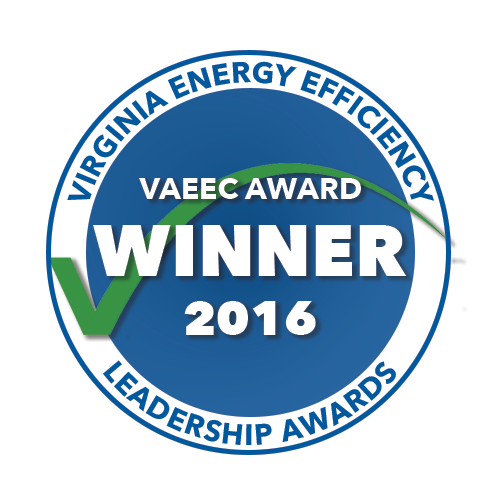
 Richmond, Virginia (November 29, 2016)
Richmond, Virginia (November 29, 2016) winners with their awards.
winners with their awards. The new Manassas Park Elementary School and Pre-Kindergarten were built with the goal to create a campus that was not only environmentally sustainable but that was also a resource to teach students about environmental stewardship. The buildings are designed to meet the American Institute of Architects (AIA) 2030 Challenge and use 50% less energy than code-compliant schools. Features include photo-sensors, which activate artificial light only when needed to supplement natural lighting; ground-source heat pumps, variable-speed pumping, pre-treatment and total energy recovery for ventilation air; natural ventilation; rainwater harvesting; low-consumption fixtures and kitchen equipment.
The new Manassas Park Elementary School and Pre-Kindergarten were built with the goal to create a campus that was not only environmentally sustainable but that was also a resource to teach students about environmental stewardship. The buildings are designed to meet the American Institute of Architects (AIA) 2030 Challenge and use 50% less energy than code-compliant schools. Features include photo-sensors, which activate artificial light only when needed to supplement natural lighting; ground-source heat pumps, variable-speed pumping, pre-treatment and total energy recovery for ventilation air; natural ventilation; rainwater harvesting; low-consumption fixtures and kitchen equipment. The team was largely responsible for fixing the flawed Property Assessed Clean Energy (PACE) legislation in 2015, which previously did not give the PACE lien priority over existing mortgage holders. Through their efforts, the PACE legislation passed easily – where previous years’ efforts to modify the statute failed – with very little opposition in the General Assembly. Since the legislation went into effect in July 2015, the team has been active in building interest, support and knowledge of the value proposition of PACE throughout the state.
The team was largely responsible for fixing the flawed Property Assessed Clean Energy (PACE) legislation in 2015, which previously did not give the PACE lien priority over existing mortgage holders. Through their efforts, the PACE legislation passed easily – where previous years’ efforts to modify the statute failed – with very little opposition in the General Assembly. Since the legislation went into effect in July 2015, the team has been active in building interest, support and knowledge of the value proposition of PACE throughout the state. The mission of Henrico County’s Energy Management program and energy manager is to develop Henrico County Government and Schools as the leading local authorities for sustainable energy use and to promote the importance of good energy management for the economic and environmental well-being of the county’s residents and employees. The Energy Management program also strives to improve energy education and foster a culture of efficiency and sustainability in the County, while the Energy Manager supports green design and construction efforts for capital projects. Completed projects include energy audits, HVAC and lighting system upgrades, participation in demand response programs, commissioning and retro-commissioning, traffic and street light upgrades, building automation systems, and construction of a 4-megawatt methane gas to electricity generator at the landfill.
The mission of Henrico County’s Energy Management program and energy manager is to develop Henrico County Government and Schools as the leading local authorities for sustainable energy use and to promote the importance of good energy management for the economic and environmental well-being of the county’s residents and employees. The Energy Management program also strives to improve energy education and foster a culture of efficiency and sustainability in the County, while the Energy Manager supports green design and construction efforts for capital projects. Completed projects include energy audits, HVAC and lighting system upgrades, participation in demand response programs, commissioning and retro-commissioning, traffic and street light upgrades, building automation systems, and construction of a 4-megawatt methane gas to electricity generator at the landfill. Community Housing Partners’ (CHP) innovative energy efficiency training project involved a live broadcast from a manufactured home in Virginia to the statewide Weatherization Assistance Program (WAP) conference in Minnesota. Having been a WAP provider for 40 years, CHP knows firsthand the importance of equipping WAP crew members with the knowledge, skills, and abilities to produce quality work resulting in maximum energy savings for the low-income households served by the program. CHP developed a 3.5 hour live-stream training session with relevant predefined topics and real-time Q&A, which enabled CHP to develop a new approach to energy efficiency training that will be replicated nationally, and potentially internationally.
Community Housing Partners’ (CHP) innovative energy efficiency training project involved a live broadcast from a manufactured home in Virginia to the statewide Weatherization Assistance Program (WAP) conference in Minnesota. Having been a WAP provider for 40 years, CHP knows firsthand the importance of equipping WAP crew members with the knowledge, skills, and abilities to produce quality work resulting in maximum energy savings for the low-income households served by the program. CHP developed a 3.5 hour live-stream training session with relevant predefined topics and real-time Q&A, which enabled CHP to develop a new approach to energy efficiency training that will be replicated nationally, and potentially internationally. Columbia Gas of Virginia’s Web-Based Home Audit Program allows residential customers to participate in their own energy analysis and places them in the “driver’s seat” of achieving an energy efficient future. Customers participating in an online home energy audit receive a customized report recommending home improvements that can be implemented to reduce natural gas usage. Through the end of 2015, CGV’s customers have achieved over $4M in savings through the program.
Columbia Gas of Virginia’s Web-Based Home Audit Program allows residential customers to participate in their own energy analysis and places them in the “driver’s seat” of achieving an energy efficient future. Customers participating in an online home energy audit receive a customized report recommending home improvements that can be implemented to reduce natural gas usage. Through the end of 2015, CGV’s customers have achieved over $4M in savings through the program. The Virginia Department of Corrections (VADOC) executed the first executive branch energy services contract (ESCO) in Virginia, leads Virginia in ESCO volume, and has embraced ESCOs as an integral part of its building renewal program. VADOC has also tied energy efficiency to its public safety mission by creating an inmate training program in energy sector skills. Additionally, VADOC employs a broad fuel portfolio including renewable and alternative energy sources
The Virginia Department of Corrections (VADOC) executed the first executive branch energy services contract (ESCO) in Virginia, leads Virginia in ESCO volume, and has embraced ESCOs as an integral part of its building renewal program. VADOC has also tied energy efficiency to its public safety mission by creating an inmate training program in energy sector skills. Additionally, VADOC employs a broad fuel portfolio including renewable and alternative energy sources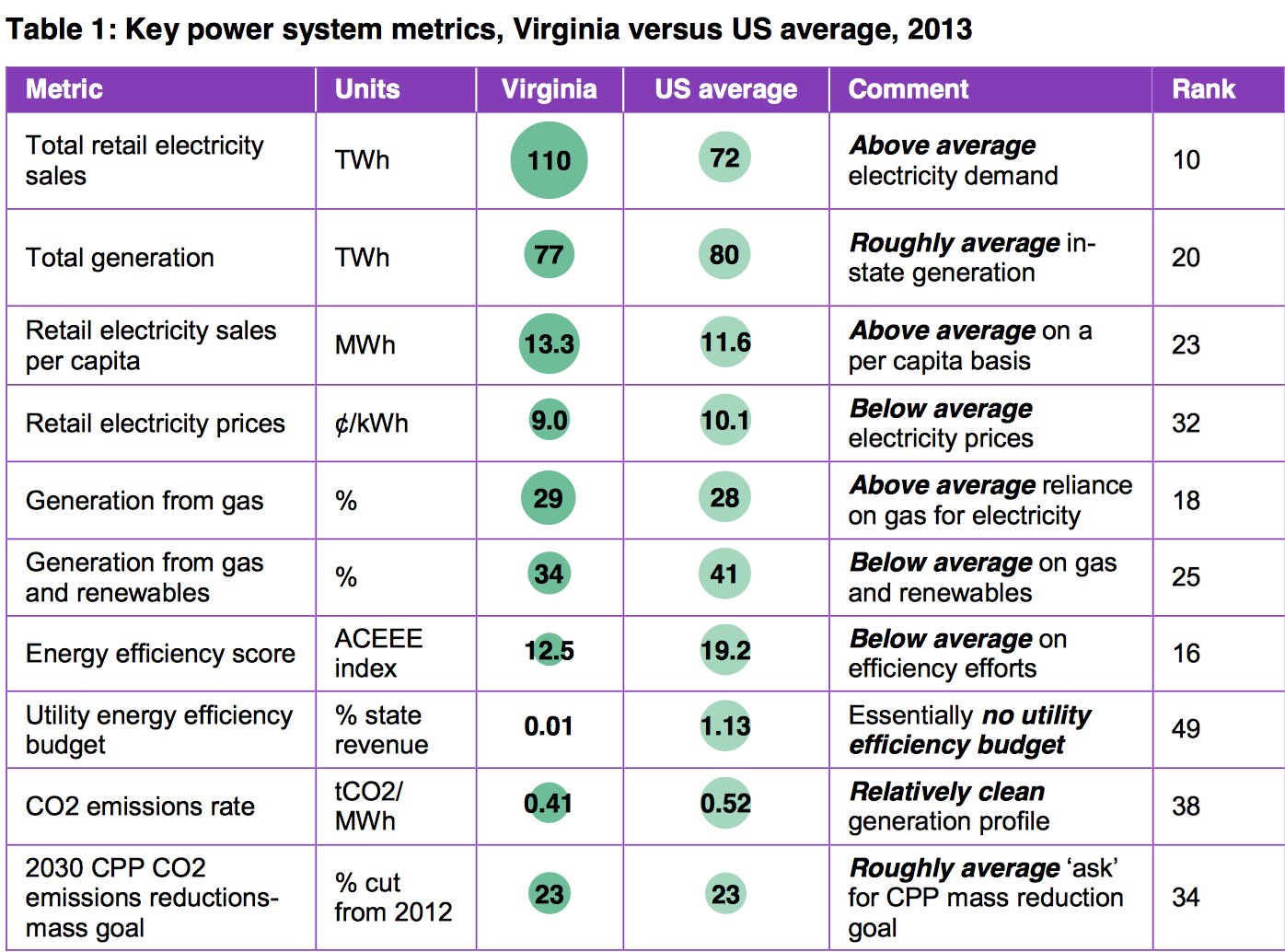


 This guest blog post was written for VAEEC by Carolyn Sloan, Manager, Federal Policy, with the
This guest blog post was written for VAEEC by Carolyn Sloan, Manager, Federal Policy, with the 


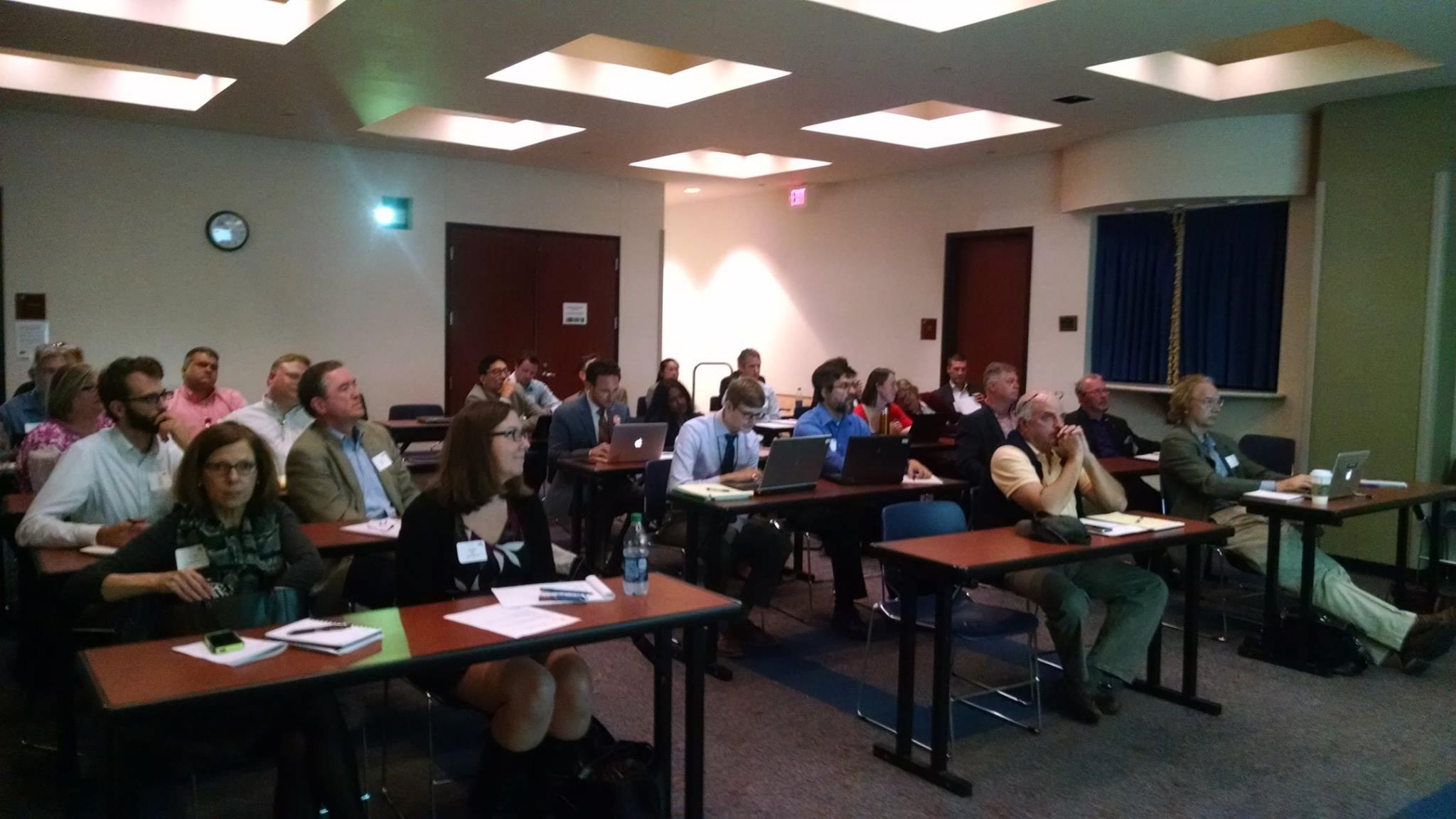
 Last week (Oct. 6, 2016), the Virginia Energy Efficiency Council held a successful workshop for utility staff, evaluators, regulators, implementers and other stakeholders on EM+V 2.0 (Evaluation, Measurement + Verification).
Last week (Oct. 6, 2016), the Virginia Energy Efficiency Council held a successful workshop for utility staff, evaluators, regulators, implementers and other stakeholders on EM+V 2.0 (Evaluation, Measurement + Verification).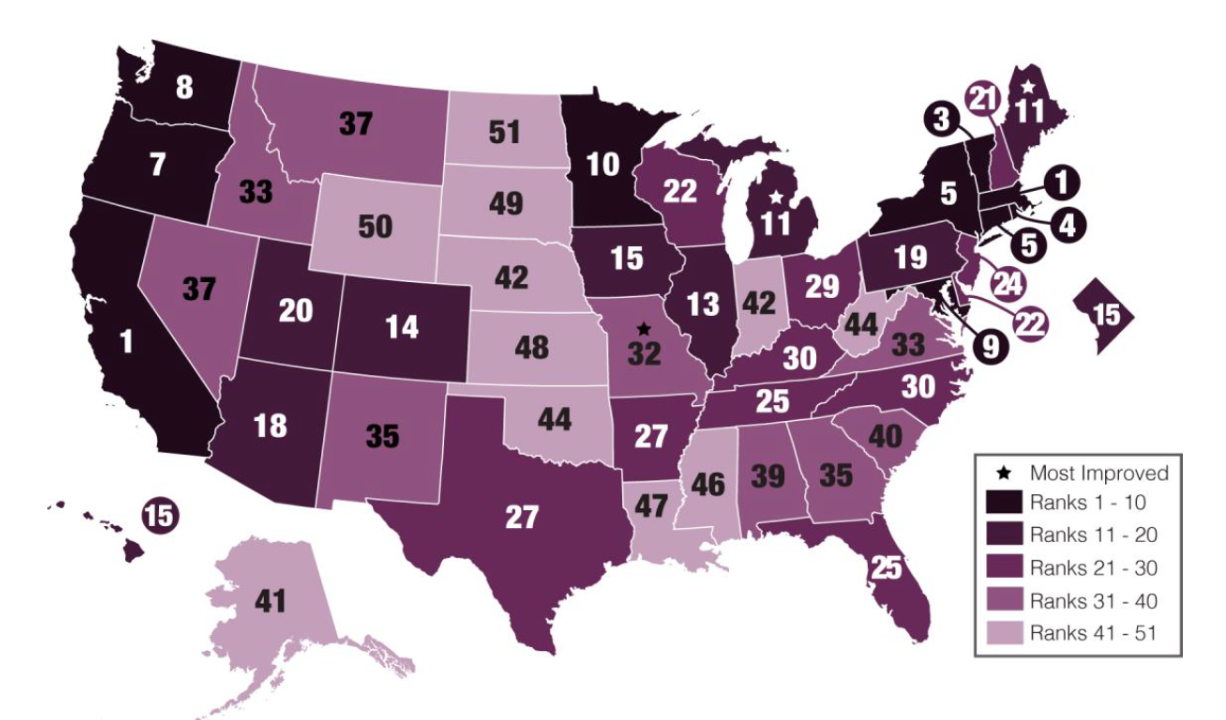
 The State Scorecard is a helpful illustration of the strengths and weaknesses of each state’s energy efficiency components and provides an opportunity for all states to learn from each other.
The State Scorecard is a helpful illustration of the strengths and weaknesses of each state’s energy efficiency components and provides an opportunity for all states to learn from each other. California reaps the benefits of CHP through a total of 28 installations. Another installation of note is their Self-Generation Incentive Program (SGIP) that provides incentive payments to support the commercialization of new, efficient CHP technologies. CA’s CHP energy resources are held to the standards of the Qualifying Facilities and CHP Program Settlement; the program provides targets and requirements that facilitate the efficient production of CHP.
California reaps the benefits of CHP through a total of 28 installations. Another installation of note is their Self-Generation Incentive Program (SGIP) that provides incentive payments to support the commercialization of new, efficient CHP technologies. CA’s CHP energy resources are held to the standards of the Qualifying Facilities and CHP Program Settlement; the program provides targets and requirements that facilitate the efficient production of CHP.
 What an inspiring day at the Clean Energy Business Roundtable in Roanoke with Virginia Governor Terry McAuliffe. Plenty of VAEEC members were represented, including Community Housing Partners, Trane, Virginia Community Capital, Oracle (OPower), Appalachian Power and Siemens.
What an inspiring day at the Clean Energy Business Roundtable in Roanoke with Virginia Governor Terry McAuliffe. Plenty of VAEEC members were represented, including Community Housing Partners, Trane, Virginia Community Capital, Oracle (OPower), Appalachian Power and Siemens.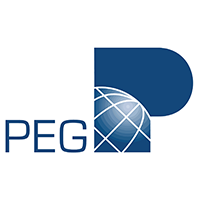
 Established in 1998,
Established in 1998,